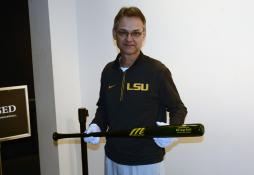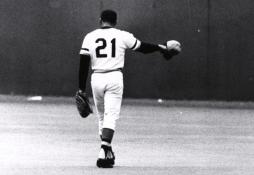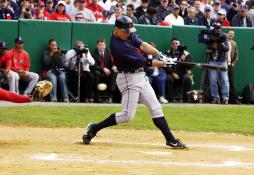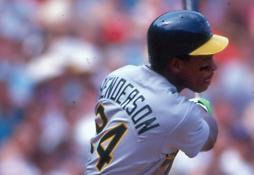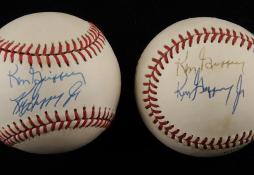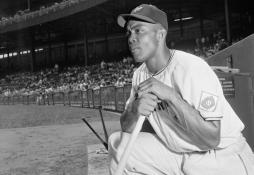- Home
- Our Stories
- Ten Named To Golden Era Ballot for Baseball Hall of Fame Election
Ten Named To Golden Era Ballot for Baseball Hall of Fame Election
Nine Players, One Executive with Greatest Impact from 1947-’72 to Be Considered Dec. 8
(COOPERSTOWN, NY) – Nine former major league players and one former executive comprise the 10-name Golden Era ballot to be reviewed and voted upon Dec. 8 at the Baseball Winter Meetings in San Diego, the National Baseball Hall of Fame and Museum announced today.
Dick Allen, Ken Boyer, Gil Hodges, Bob Howsam, Jim Kaat, Minnie Minoso, Tony Oliva, Billy Pierce, Luis Tiant and Maury Wills are the candidates for Golden Era Committee consideration for Hall of Fame election for the Class of 2015. Howsam is included for his contributions as an executive, while the other nine are inclusions for their on-field careers. Allen, Kaat, Minoso, Oliva, Pierce, Tiant and Wills are living; all other candidates are deceased.
Any candidate to receive votes on 75 percent of the ballots cast by the 16-member Golden Era Committee will earn election to the National Baseball Hall of Fame and will be inducted in Cooperstown on July 26, 2015, along with any electees who emerge from the 2015 Baseball Writers’ Association of America election, to be announced on Jan. 6, 2015.
The 10 Golden Era finalists were selected by the BBWAA-appointed Historical Overview Committee from all eligible candidates among Managers, Umpires, Executives and Long-Retired Players whose most significant career impact was realized during the 1947-72 time period. Eligible candidates include: Players who played in at least 10 major league seasons, who are not on Major League Baseball’s ineligible list, and have been retired for 21 or more seasons; and Managers, Umpires and Executives with 10 or more years in baseball.
Allen, Howsam, Pierce and Wills are new additions for consideration by the Golden Era Committee, which elected Ron Santo in December 2011, the last time the Golden Era Ballot was considered. Buzzie Bavasi, Charlie Finley and Allie Reynolds were previously considered for election in the fall of 2011 but did not return to the 2015 Golden Era ballot.
The Golden Era ballot was determined this fall by the Historical Overview Committee, comprised of 11 veteran historians: Dave Van Dyck (Chicago Tribune); Bob Elliott (Toronto Sun); Rick Hummel (St. Louis Post-Dispatch); Steve Hirdt (Elias Sports Bureau); Bill Madden (New York Daily News); Ken Nigro, (formerly Baltimore Sun); Jack O’Connell (BBWAA secretary/treasurer); Tracy Ringolsby (MLB.com); Glenn Schwarz (formerly San Francisco Chronicle); Claire Smith (ESPN); and Mark Whicker (Los Angeles News Group).
The 16-member Hall of Fame Board-appointed electorate charged with the review of the Golden Era ballot features Hall of Fame members Jim Bunning, Rod Carew, Pat Gillick, Ferguson Jenkins, Al Kaline, Joe Morgan, Ozzie Smith and Don Sutton; major league executives Jim Frey (retired), David Glass (Royals), Roland Hemond (Diamondbacks), and Bob Watson (retired); along with veteran media members Steve Hirdt, Dick Kaegel, Phil Pepe and Tracy Ringolsby. The Golden Era electorate will meet to discuss and review the candidacies of the 10 finalists as part of baseball’s Winter Meetings, December 7-8 in San Diego.
The 10 candidates for Golden Era consideration for the Class of 2015:
• Dick Allen played 15 seasons from 1963-77 for five teams, spending nine seasons with the Phillies, compiling 351 home runs, 1,119 RBI and a .292 career average. Was named the 1972 AL Most Valuable Player and the 1964 NL Rookie of the Year, with seven career All-Star selections.
• Ken Boyer played 15 seasons as a third baseman with the Cardinals, Mets, White Sox and Dodgers, earning seven All-Star Game selections and winning the 1964 National League Most Valuable Player Award en route to leading the Cardinals to a World Series championship.
• Gil Hodges was named to eight All-Star Games in an 18-year big league career as a first baseman with the Dodgers and Mets, winning three Gold Glove Awards and leading the Dodgers to seven National League pennants and two World Series titles. As a manager, Hodges led the 1969 Miracle Mets to the World Series title.
• Bob Howsam was the architect of the Big Red Machine Cincinnati Reds Championship teams, serving as General Manager from 1967-77. From 1947-62, Howsam led the minor-league Denver Bears and was a founder of the Continental League, making the push for baseball’s expansion into Colorado.
• Jim Kaat pitched 25 seasons with the Senators, Twins, White Sox, Phillies, Yankees and Cardinals, winning 283 games over the course of four different decades. Kaat was named to three All-Star Games and helped the Cardinals win the 1982 World Series.
• Minnie Minoso played 17 seasons with the Indians, White Sox, Cardinals and Senators, earning seven All-Star Game selections and three Gold Glove Awards as an outfielder. A native of Cuba, he blazed a trail for Latin American players in the big leagues starting in the 1950s.
• Tony Oliva played 15 seasons for the Twins, winning three batting titles and leading the American League in hits five times. He was named to eight All-Star Games and won the 1964 AL Rookie of the Year Award.
• Billy Pierce complied a 211-169 record with a 3.27 ERA in 18 seasons, 13 with the Chicago White Sox. A seven-time All-Star, he led the league in complete games three straight seasons, totaling 193 overall. Posted lowest ERA in the A.L. in 1955 (1.97).
• Luis Tiant won at least 20 games in four of his 19 big league seasons with the Indians, Twins, Red Sox, Yankees, Pirates and Angels, finishing his career with 229 wins and a 3.30 ERA while earning three All-Star Game selections. He won two American League ERA titles and led the league in shutouts three times.
• Maury Wills played 14 seasons from 1959-1972, 12 with the Los Angeles Dodgers, with a .281 lifetime average and 586 career stolen bases. The 1962 N.L. MVP was a seven-time All-Star and two-time Gold Glove Award winner.
More information on each candidate is available by visiting www.baseballhall.org.
Ron Santo was elected by the Golden Era Committee in 2011, receiving 15 of 16 votes to earn a spot in the Hall of Fame Class of 2012. Other voting results from the 2011 election: Jim Kaat (10 votes, 62.5%); Gil Hodges (9 votes, 56.25%); Minnie Minoso (9 votes, 56.25%); Tony Oliva (8 votes, 50%); Buzzie Bavasi, Ken Boyer, Charlie Finley, Allie Reynolds and Luis Tiant each received less than three votes.
The 2011 16-member Golden Era Committee was comprised of Hall of Fame members Hank Aaron, Pat Gillick, Al Kaline, Ralph Kiner, Tommy Lasorda, Juan Marichal, Brooks Robinson and Billy Williams; major league executives Paul Beeston (Blue Jays), Bill DeWitt (Cardinals), Roland Hemond (Diamondbacks), Gene Michael (Yankees) and Al Rosen (retired); and veteran media members Dick Kaegel, Jack O’Connell and Dave Van Dyck. Hall of Fame Chairman of the Board Jane Forbes Clark served as the non-voting chairman of the Golden Era Committee.
About the Era Committees
The Golden Era Committee is the second of a three-year cycle of consideration for Managers, Umpires, Executives and Long-Retired Players by Era, as opposed to the previous consideration by classification, with changes approved and announced by the Hall of Fame’s Board of Directors in 2010. The 2014 meeting will mark the second time candidates from the Golden Era have been considered by a committee system. Both the ballot and electorate are created anew with each cycle for consideration.
The Era Committees maintain the high standards for earning election to the National Baseball Hall of Fame, with focus on three time periods: Expansion (1973-present); Golden (1947-1972) and Pre-Integration (1871-1946), as opposed to the previous four Committees on Baseball Veterans, which considered the four categories of candidates. Three separate electorates consider by eras a single composite ballot of managers, umpires, executives and long-retired players on an annual basis, with Pre-Integration Era Committee candidates to be considered at the 2015 Winter Meetings for Induction in 2016 and the Expansion Era Committee candidates to be considered again at the 2016 Winter Meetings for Induction in 2017. The Golden Era Committee will next meet at the 2017 Winter Meetings for Induction in 2018.
Candidates remain eligible in perpetuity through the Era Committee process, with new ballots constructed by the Historical Overview Committee the fall prior to each election.



